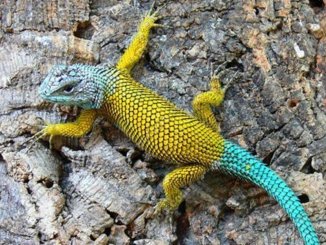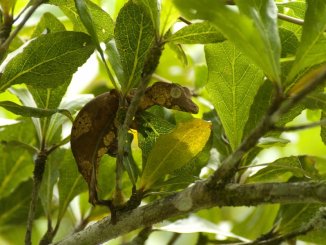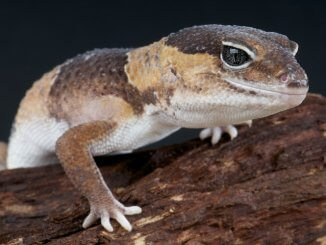The mangrove monitor is a large species of monitor lizard that grows up to four feet long. The mangrove monitor lizard’s dark body with bright yellow spots makes this a popular lizard among reptile enthusiasts.
The mangrove monitor is native to mangrove swamps and wetlands in the Western Pacific.
Only highly experienced reptile enthusiasts should keep mangrove monitors because the lizards are difficult to care for. Mangrove monitors have a dangerous bite and need a large space to live in because they grow quickly.
Mangrove Monitor Overview
| Common Name | Mangrove monitor, mangrove goanna, or the Western Pacific monitor lizard |
| Scientific Name | Varanus indicus |
| Natural Habitat | Hot and humid areas with plenty of tree cover near to rivers. The mangrove monitor comes from New Guinea, Australia, and the Marshall Islands |
| Adult Size | 3.5–4 feet |
| Average Lifespan | 12–20 years |
| Diet | Carnivorous, including fish, crabs, insects, birds, rodents, crickets, mealworms, and smaller lizards |
| Housing | An enclosure of at least 6x5x4 ft, with cypress mulch, reptile carpet, live plants, rocks, basking spots, wood, a large water dish, and plenty of hiding spots. Keep the enclosure between 82–90°F with basking spots as warm as 97°F |
| Experience level | Expert |
Origin
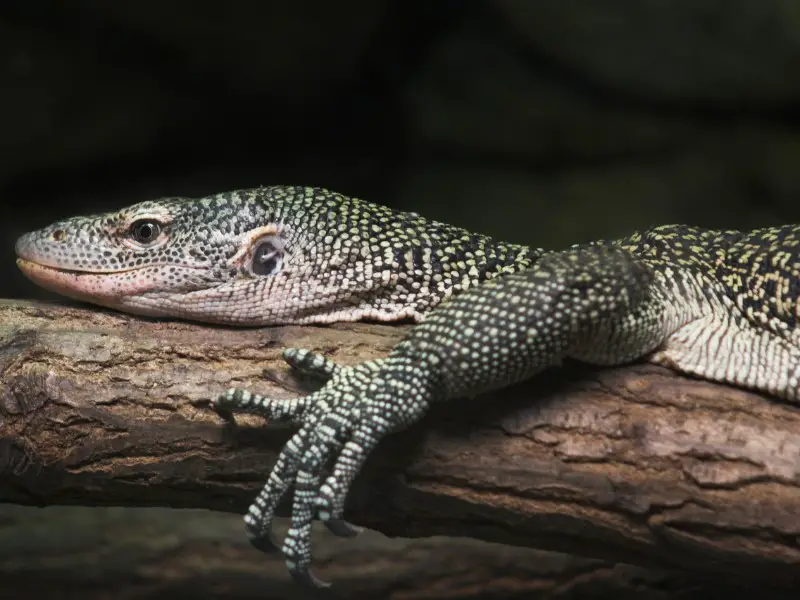
Mangrove monitor (Varanus indicus) lizards are commonly found in the Western Pacific in Australia, New Guinea, and the Marshall Islands. In the wild, the mangrove monitor lives in hot and humid areas close to rivers or bodies of water, with plenty of trees to climb. The lizard can be found in mangroves, inland lakes, and damp forests.
Mangrove monitors like to swim and catch fish as part of their natural diet. Mangrove monitors are also known to swim across the sea to different islands.
Appearance and Behavior
The mangrove monitor looks similar to other monitor lizards with its sturdy legs, five sharp-clawed toes, and long neck and head. The forked tongue of a mangrove monitor is dark purple, surrounded by sharp, serrated teeth. The mangrove monitor has a long, heavy tail which it uses to swim.
The body of a mangrove monitor is black with bright yellow spots. This coloring sets the mangrove monitor apart from other monitor lizards.
Male and female mangrove monitors are difficult to tell apart because they have similar body shapes. A female mangrove monitor has a slightly longer abdomen, while a male mangrove monitor has longer forelimbs and head, and a wider chest.
Size and Lifespan
Newly-born mangrove monitors are 9–10 inches long and grow up to 3.5–4 feet when fully grown. Mangrove monitors grow quickly and should be placed in an adult-sized tank from a young age.
Mangrove monitors live up to 20 years in captivity when looked after correctly. Give mangrove monitors enough space to live, with a healthy carnivorous diet to prolong their lifespan.
Keeping a mangrove monitor requires long-term commitment due to this lizard’s long lifespan.
Temperament
The mangrove monitor is a solitary lizard that is nervous when first introduced to a new habitat. Give the mangrove monitor plenty of hiding spots in a large enclosure to help it feel secure. Mangrove monitors are better kept separate until breeding season.
Mangrove monitors are fast and aggressive when they feel threatened, and their bite is harmful to humans. Mangrove monitors release venom when biting their prey and while their teeth will cause damage and pain, their venom isn’t deadly to humans.
Often when threatened, mangrove monitors defecate on the perceived threat. Mangrove monitors don’t like being handled and will lash out with their teeth and tails if they are stressed.
Housing Mangrove Monitors
In the wild, mangrove monitors live in hot and humid areas near rivers, while enjoying damp forests filled with vegetation and trees. Mangrove monitors stay close to water where they swim to catch fish to eat.
Keep the mangrove monitor’s enclosure warm with heaters, and filled with live plants. Place a large water dish in the enclosure to give the mangrove monitor a place to swim.
Keep the mangrove monitor lizard in a custom-built enclosure to best accommodate the adult’s large size, and to provide plenty of space for decorating with branches to climb and water to swim in. A unique enclosure offers more flexibility to create an environment similar to the natural habitat of the mangrove monitor.
Enclosure size
While juvenile mangrove monitors can be kept in a 20-gallon tank or vivarium, it is better to place them directly in an adult-sized enclosure to accommodate their large and rapid growth.
Make the custom-built mangrove monitor enclosure at least 6 feet long, 5 feet wide, and 4 feet high. Mangrove monitors will feel more comfortable and secure in larger enclosures like this one. Add vertical branches for these avid climbers to enjoy.
Lighting
Keep the lighting stable in the mangrove monitor’s enclosure to keep the lizard healthy. A mangrove monitor needs 12 hours of light and 12 hours of darkness, which can be created with a timer attached to lightbulbs.
The enclosure’s light source can come from heat lamps, UVB lights, or fluorescent lighting. All bulbs should be placed outside of the enclosure to prevent the mangrove monitor from burning.
Temperature and Humidity
Keep the mangrove monitor enclosure hot and humid like the lizard’s natural environment, to extend the lizard’s lifespan.
The general temperature in a mangrove monitor’s enclosure should be stable, between 82°F and 90°F. Reduce the nighttime temperatures to 70°F or 75°F. Raise the temperature around the basking area to 95°F or 97°F using regular reptile heating lamps.
Maintain a level of 70%–90% humidity in the mangrove monitor’s enclosure at all times to keep the lizard healthy. To maintain the humidity levels, manually mist the enclosure twice a day or place an automatic mister in the enclosure. Use a hygrometer to check the humidity levels often.
Although a mangrove monitor sheds old skin with ease, mist the enclosure more often during shedding season to help the shedding process. When a mangrove monitor starts shedding, ensure that there is plenty of water in the enclosure.
Substrate and Decoration
Add cypress mulch, newspaper, or reptile carpet to the enclosure to help keep the humidity levels stable. Soil can be used as a substrate but is difficult to keep clean. Mangrove monitors like to burrow in the substrate, so make the substrate 7–8 inches deep.
The mangrove monitor’s enclosure should be filled with live plants and vertical branches because this lizard enjoys climbing and basking in trees. Give the mangrove monitor space to relax by creating basking areas with flat rocks. Create sheltered areas and hides with moss and cholla wood.
Place a large water tub in the mangrove monitor’s enclosure to give the lizard a source to drink from, as well as a place to play and rest. Add coconut bark to the enclosure as a moisture-holding bedding option.
Cleaning
Keep the mangrove monitor’s enclosure clean by regularly changing the substrate. Reptile carpets and glass surfaces should be cleaned every day with hot water and reptile-safe disinfectant to remove the monitor’s feces. Remove the mangrove monitor from the enclosure before cleaning.
Take care when removing the mangrove monitor from the enclosure. Use reptile gloves to prevent harmful bites.
Mangrove Monitor Care
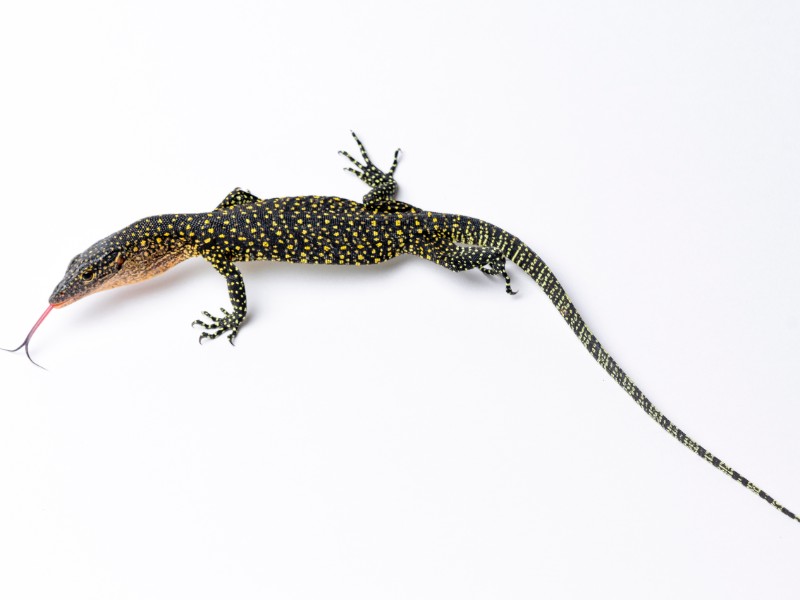
Mangrove monitors are difficult to care for, and recommended as pets only for experienced reptile owners. Mangrove monitors require a well-varied carnivore diet, plenty of water, and should not be handled often.
Mangrove monitors are hardy but may develop common illnesses such as infections, digestive issues, and calcium deficiency.
Food and Water
In the wild, mangrove monitors are opportunistic carnivores that eat a varied diet. In captivity, feed the mangrove monitor a wide range of foods including rodents, crabs, fish, insects, super worms, and hard-boiled eggs. Adult mangrove monitors may enjoy seafood, including sprats, prawns, and crayfish.
Feed an adult mangrove monitor a mixed diet four to five times each week, depending on the mangrove monitor’s preference. Juvenile mangrove monitors should be fed smaller foods such as pinky mice, crickets, mealworms, and ground turkey. Feed a juvenile mangrove monitor every day while slowly switching to every other day as the young lizard begins to eat less.
When feeding a mangrove monitor boneless meat, add a dusting of calcium to provide the mangrove monitor with the right nutrients. Live feeding may help a mangrove monitor adjust to a new enclosure and keep its natural hunting instincts.
A mangrove monitor requires plenty of water in the enclosure to drink and swim in. The water tub must be big enough for the mangrove monitor to submerge completely. The water tub will keep the enclosure’s humidity levels stable and help the mangrove monitor during shedding.
Handling
Only handle a mangrove monitor when it is necessary, and use reptile gloves to protect your hands from harmful bites. Mangrove monitors are nervous in new enclosures and will take a long time to adjust to certain settings. During the transition period, mangrove monitors may lash out and bite when held. Be aware that the mangrove monitor may defecate on you if it feels threatened.
Mangrove monitors that are adjusting to a new environment may be skittish when anyone is near their enclosure. People should be kept away during this transition time.
Common Health Issues
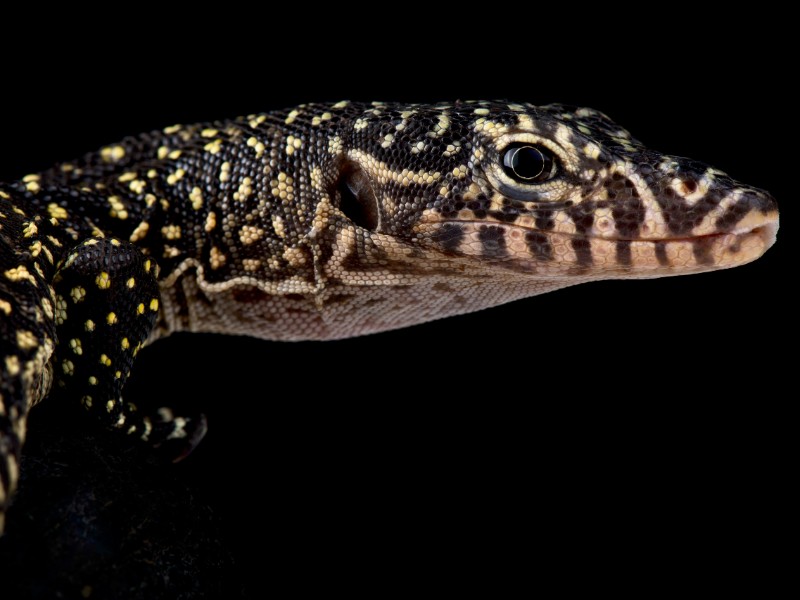
Mangrove monitors are hardy lizards, but can still develop common illnesses due to extreme stress. Care for your lizard correctly to limit stress, and watch out for the common illnesses to keep your mangrove monitor healthy.
General infections may occur in a mangrove monitor if it is highly stressed, injured, or if the enclosure is not kept clean. Signs of infection include loss of appetite, swelling, lethargy, and discoloration.
Respiratory infections in mangrove monitors are caused by cold and damp environments. Signs of a respiratory infection are similar to the signs of other general infections, but with wheezing and difficulty breathing.
Mangrove monitors can experience bowel blockages and other digestive issues due to a too-cold environment, lack of water, and as a result of eating indigestible materials such as small stones or sand.
Wounds on the mangrove monitor can become infected when not treated correctly. Seek veterinary care if a mangrove monitor injures itself, whether the injury is to its skin, claws, or toes.
Calcium deficiency in a mangrove monitor is known as a metabolic bone disease (MBD) and occurs due to a lack of correct lighting, and poor vitamin D3 and calcium in the diet. MBD results in extreme weight loss, painful joints, and swelling. Place adequate UVB light in the mangrove’s enclosure and supplement food with calcium and vitamin D3 supplements to prevent MBD.
Over-supplementation of calcium will have negative results for a mangrove monitor because too much calcium can cause hypercalcemia. To prevent hypercalcemia, add an occasional ¼ teaspoon of calcium powder to the mangrove monitor’s food.
Breeding
Breeding mangrove monitors should only be done by experienced reptile owners because the breeding process is dangerous and complicated.
Male mangrove monitors attempt to lure the female mangrove monitor by controlling and sometimes fighting the female lizard.
Female mangrove monitors will produce a clutch of between two and 12 eggs. Female mangrove monitors that are well fed and healthy can produce up to five clutches in two years.
Mangrove monitor eggs are long and white, measuring between one and two inches long. Female mangrove monitors guard the eggs during the incubation period but leave the hatchlings to fend for themselves once hatched.
Mangrove monitors will hatch between seven and eight months after the eggs are laid.
Choosing and Buying a Mangrove Monitor
Mangrove monitors can be found at certain pet stores or reputable breeders. Online exotic pet stores also sell mangrove monitors. The cost of a mangrove monitor is between $120 and $400.
Buy captive-bred mangrove monitors instead of wild-caught mangrove monitors where possible, because captive-bred lizards adjust the best to new enclosures. Wild-caught mangrove monitors must be treated for bacterial and parasitic infections before they are sold.
A mangrove monitor should only be kept by an experienced reptile owner and is not a beginner-friendly reptile pet.

